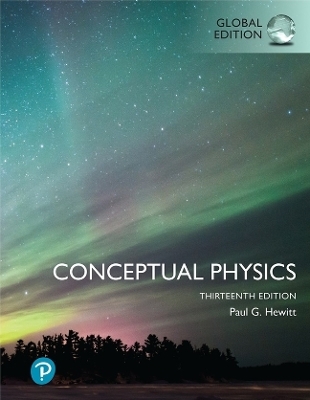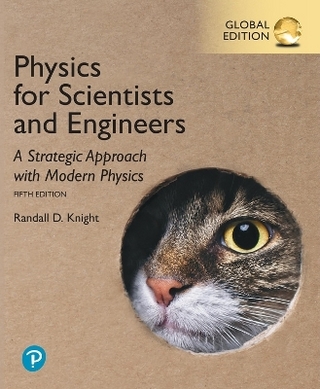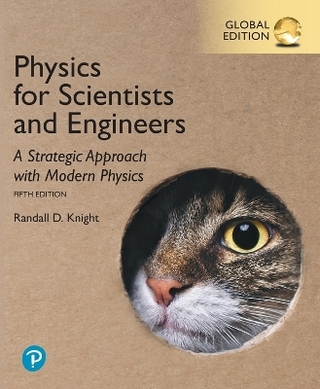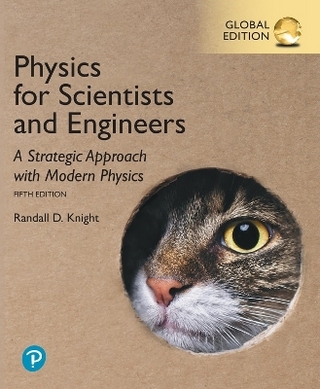
Mastering Physics with Pearson eText for Conceptual Physics, Global Edition
Pearson Education Limited (Hersteller)
978-1-292-43744-6 (ISBN)
Actively engagestudents in learning and loving physics
Paul Hewitt's best-selling ConceptualPhysics defined the liberal arts physics course over 30 years agoand continues as the benchmark. Hewitt's text is guided by the principle of"concepts before calculations" and is famous for engaging studentswith real-world analogies and imagery to build a strong conceptualunderstanding of physical principles, ranging from classical mechanics tomodern physics.
The 13th Edition continues to makephysics delightful for students with informative and fun Hewitt-Drew-Itscreencasts, updated content and applications, and new engaging activities.
Paul G. Hewitt Becoming a physics instructor and textbook authordidn't seem a likely outcome of my earlier years. I grew up in Saugus (nearBoston), Massachusetts. In my high school years, an influential counselorconvinced me that I wouldn't have to take academic courses due to my talent forart. My passions at the time were drawing comic strips, rink roller-skating,and especially boxing, which helped repel school bullies. At age 17, I won thesilver medal of the New England Amateur Athletic Union in the 112-pound class.Shortly after that, I delivered newspapers, painted signs, and learnedsilk-screen printing in Boston, where I met life-long friend Ernie Brown, whoinfluenced me to spend two winters with him in Miami, Florida. I dedicated theeleventh edition of Conceptual Physics to Ernie. In 1953, during the Koreanconflict, I was abruptly drafted into the Army. I was fortunate, however, thatthe war ended on my last day of basic training at Camp Carson in ColoradoSprings. My Army discharge occurred during the craze of uranium prospecting,which nurtured the hope of financial security. I took that gamble and remainedin Colorado to prospect for uranium, supporting myself as a sign painter in thetown of Salida. I discovered uranium-tainted rock in the Sangre de ChristoMountains that raised my hopes, but not my income. More importantly, Idiscovered and fell in love with Millie Luna. Winter snow prevented access tomy uranium claims, so I went back to Saugus, and then to escape the cold NewEngland winters, I returned to Miami. Life-changing events occurred inMiami. First, I married Millie. Second, I met sign painter and science buffBurl Grey and his intellectual mentor, Jacque Fresco. Both inspired me topursue a life of science. I returned north and with the G.I. Bill, enrolled atNewman Preparatory School in Boston to make up for high-school deficiencies. Atthe age of 27, I began college at Lowell Technological Institute (now theUniversity of Massachusetts Lowell). After I received a Bachelor of Science degreein physics, Millie and I and our two children ventured west, where I would earna Master of Science degree in physics at Utah State University (USU). There, Iwas inspired by the extraordinary teaching of Farrell Edwards and John J.Merrill. USU friends Huey and Sue Johnson influenced us to follow them to SanFrancisco, where Huey, a passionate environmentalist, began his career as WesternDirector of the famed Nature Conservancy and soon became California's Secretaryof Resources during Jerry Brown's administration. Huey also founded The Trustfor Public Land, an organization that saves tracts of land from unwantedcommercial development, and he later founded the nonprofit Resource RenewalInstitute. Best friend extraordinaire Huey passed away in 2020 fromcomplications after a fall. It was with Huey's assistance in 1964 that I washired as a long-term substitute at City College of San Francisco (CCSF). My teaching assignment was thecourse least popular among my colleagues, Physics 10, which was geared towardnon-science majors, the very students I wanted to reach. My teaching goal wasnot to swell the ranks of physicists, but to share my love of physics with allstudents. I very soon discovered that the best of my algebraic derivations wereunappreciated. Nor did students think much of my simple problems that usedequations as recipes to come up with numerical answers. My teaching evolved to"physics without numbers," and Physics 10 soon became the mostpopular elective course on campus. I yearned to teach from a new and excitingtextbook, Physics for the Inquiring Mind, by Eric Rogers, but mydepartment chair found it unacceptable because it was too large and heavy forstudents to tote around. That meant I would have to writemy own book. Inspired by the Rogers book and Basic Physics, a new,clearly written textbook by Kenneth Ford, I frantically spent the summer of1969, the year of the first Moon landing, creating Conceptual Physics.The spiral-bound result was graciously printed on campus by the collegebookstore. Its coverage of topics was in step with my nemesis as a student:information overload. It covered only the fundamentals of physics. It had nonumerical problems requiring even simple algebra. None. As such, it was a quitelocal CCSF book. Enrollment for Physics 10 hadgrown to more than a thousand per semester. Curious textbook sales representativesthought that Conceptual Physics could be more than a localbook. To make a long and interesting story short, Little, Brown and Companypublished it in 1971 (50 years ago). This was at a time when college studentsnationwide were demanding relevance in their courses. With its subtitle, A New Introduction to Your Environment, ConceptualPhysics was seen as very relevant. To add to the accuracyof the physics, Ken Ford volunteered his editorial pen to my writing. Idedicated the eighth and eleventh editions to him. Conceptual Physics becamethe dominant book for liberal arts physics courses in the United States, andalso internationally. Teaching was not confined toCCSF. On Wednesday evenings, I taught at the San Francisco Exploratorium. I wasoften honored when founder Frank Oppenheimer sat in on my classes. When musicalsounds was the topic, with his collection of woodwind instruments, Frank didthe teaching, and I sat in. Wonderful times teaching with Frank. As an author, I never went thecommon route of following an introductory textbook with an algebra/trigonometry-basedbook and then a calculus-based textbook. Instead, I elected to keepimproving Conceptual Physics for non-science students, edition after edition, a continuous strivingto increase the clarity of physics topics, to make physics a course thatstudents could love. For an algebra-based course, Phil Wolf and I wrote aproblem-solving book to supplement Conceptual Physics. It is now animportant complement to this thirteenth edition. In my personal life, my wifeMillie peacefully passed away in 2004, leaving me with three wonderful childrenand seven well-loved grandchildren. A year later I married Lillian Lee. Both ofmy marriages were to impressive women. Today, my wife Lillian, with her eye fordetail, adds clarity to my writing. Hence, I dedicate this edition to her, as Idid with previous editions. I never traveled outside of theUnited States until age 40. Since then, summers have been devoted to worldtravel. My teaching took me further afield as well, mainly to the University ofCalifornia at both Berkeley and Santa Cruz, and the two university campuses inHawaii. In Hawaii, I was also invited to teach in a video studio. Little did Irealize that those lectures would remain popular today. A move from Hilo, Hawaii, to St.Petersburg, Florida, brought me closer to my pal from my roller-skating days,Paul Ryan (pictured in all my books). Lil and I now split our time between St.Petersburg and San Francisco, continually polishing the lens through whichstudents can more clearly view their world. Nature's major rules are revealedin the laws of physics, all nicely summarized in their equations. Teachingthese equations as the rules of nature has been an awesome experience. More awesome is being born. Thechances of being born a healthy human are so miniscule that being alive is thehighest prize of the universe. But that prize comes with a certainty: beingborn means eventually dying. Before birth, our experience of the universe andall its happenings was blank. With no consciousness, there was nothing. If thatblank state is our fate after death, then there's nothing to fear. Now, ifthere's more, hooray - But there needn't be. Death as the price of birthis a fair cosmic bargain. Along with grieving the loss of loved ones, we shouldcelebrate that they knew life.
About Science
Part One: MECHANICS
Newton's First Law of Motion: Inertia
Linear Motion
Newton's Second Law of Motion
Newton's Third Law of Motion
Momentum
Energy
Rotational Motion
Gravity
Projectile and Satellite Motion
Part Two: PROPERTIES OF MATTER
The Atomic Nature of Matter
Solids
Liquids
Gases
Part Three: HEAT
Temperature, Heat, and Expansion
Heat Transfer
Change of Phase
Thermodynamics
Part Four: SOUND
Vibrations and Waves
Sound
Musical Sounds
Part Five: ELECTRICITY AND MAGNETISM
Electrostatics
Electric Current
Magnetism
Electromagnetic Induction
Part Six: LIGHT
Properties of Light
Color
Reflection and Refraction
Light Waves
Light Emission
Light Quanta
Part Seven: ATOMIC AND NUCLEAR PHYSICS
The Atom and the Quantum
Atomic Nucleus and Radioactivity
Nuclear Fission and Fusion
Part Eight: RELATIVITY
Special Theory of Relativity
General Theory of Relativity
Author Profile Appendices
A. On Measurement and Unit Conversions
B. More About Motion
C. Graphing
D. Vector Applications
E. Exponential Growth and Doubling Time
Odd-Numbered Answers Glossary Credits Index
| Erscheint lt. Verlag | 21.10.2022 |
|---|---|
| Verlagsort | Harlow |
| Sprache | englisch |
| Themenwelt | Naturwissenschaften ► Physik / Astronomie |
| ISBN-10 | 1-292-43744-8 / 1292437448 |
| ISBN-13 | 978-1-292-43744-6 / 9781292437446 |
| Zustand | Neuware |
| Haben Sie eine Frage zum Produkt? |
aus dem Bereich


